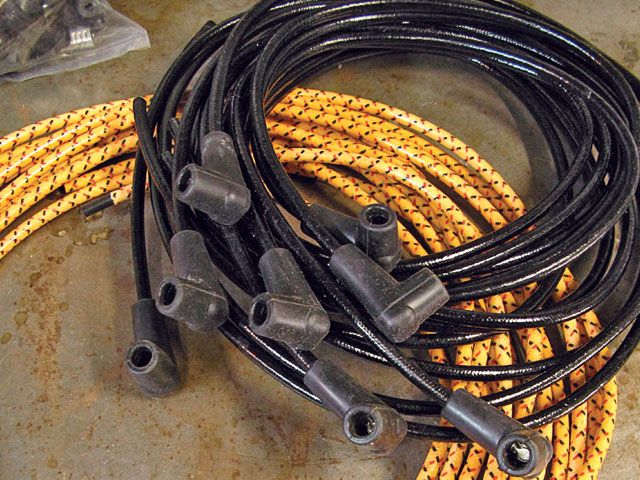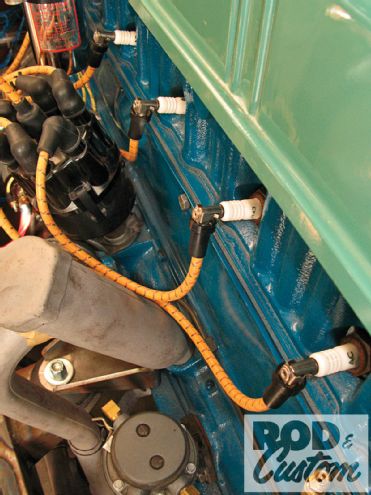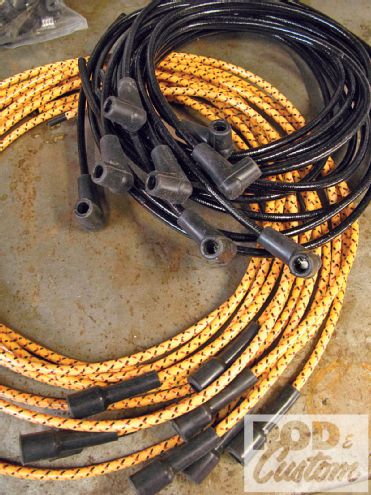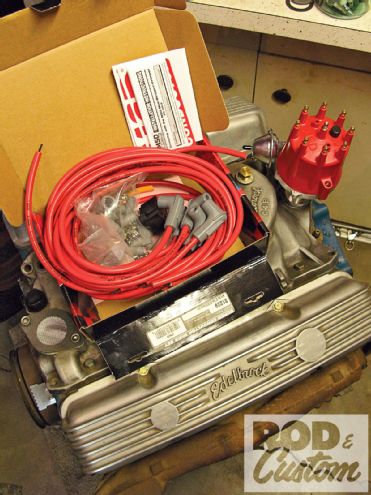
Have you ever put much thought into the specifics of your car's ignition system-above and beyond the simple fact of whether it's working or not, that is? More specifically, how about those spark plug wires you're running? Aside from passing a quick visual inspection to detect any loose connections, burnt insulation, and whatnot, are you even using the correct type of wire to begin with? Yeah, they may refer to this as the "secondary" side of the ignition, but oftentimes, some rarely give their plug wires a second thought ... unless it's which color goes best with the engine compartment.

Lately, we've been seeing quite a few "new" builds using "old"-style spark plug wires. To the naked eye, the lacquered, cloth-wrapped wires look identical to the original ones-and in many cases, they are just that ... NOS solid-core, non-suppression wires. They could, however, be a modern spiral-core dual-insulated wire hiding behind a braided cloth outer shell. Each has its place, so before you go off and ruin a brand-new electronic ignition system, make sure you're well aware of what goes where and what does what.
 What was once old ...Vintage Reproduction Parts now offers their modern version of the cloth-covered plug wire. Though not of the spiral-wound construction, the stainless core wire does have better insulating capabilities than the original type it's based on. The lacquered cloth housing is available in yellow (with red/black accent) or black, in both straight and 90-degree versions.
What was once old ...Vintage Reproduction Parts now offers their modern version of the cloth-covered plug wire. Though not of the spiral-wound construction, the stainless core wire does have better insulating capabilities than the original type it's based on. The lacquered cloth housing is available in yellow (with red/black accent) or black, in both straight and 90-degree versions.
First off, your particular ignition system will tell you what type of plug wire you should or-more importantly-shouldn't use. Early points-style ignitions and magnetos used low-resistance wires to carry a lower voltage as compared to modern systems, which can easily carry up to twice the load, thus requiring a higher tolerance wire. Running a modern, spiral-core suppression wire with the early ignition can actually decrease the voltage being carried to the plugs; running the early solid-cores with a high-output (breakerless, capacitive discharge, or HEI) system can easily result in damaged electronic components for the exact opposite reason. There's more to a plug wire than the color of its skin.
The only way to accurately tell one type of wire from another is to go beneath its skin to reveal its core construction. Basically, there are three main types of ignition wire: solid-core, carbon-suppression, and spiral-wound. As previously mentioned, each has its place when it comes to specific types of ignition systems-rarely can they perform up to par when used outside their initial realm (mostly applies to the solid conductor wires, which can't be suppressed). A solid wire offers virtually no resistance, as it was designed to deliver the maximum amount of spark from a low-output ignition. This type of plug wire is perfectly suited for a points-style distributor (but NOT one that's been converted to electronic!) or with a magneto; used with an electronic ignition, a solid wire cannot protect the sensitive components like a properly insulated wire can. A carbon-conductor wire, on the other hand, does offer the shielding characteristics needed for a "basic" electronic ignition (with the terminals acting as resistors), however, its high level of suppression (designed to prevent noise/radio interference) equates to reduced spark travel. A spiral-wound or induction-type wire offers the same or more high suppression as a carbon-core, but unlike its predecessor, has the low resistance necessary for optimum spark, making it perfectly suited for performance ignition systems. Knowing the differences between the types of wires and ignition systems is important, but when it comes to the higher-end of the performance scale, always refer to the manufacturer's requirements, specifically the ohm resistance.
When purchasing an aftermarket performance wire, such as an MSD 8.5mm Super Conductor, Mallory 8mm Pro Sidewinder, or the "little" underdogs, ACCELL 5mm Ferro-Spiral, the final decision may ultimately rely on personal preference, as they're all quality high-performance wires. But not every ignition requires such a high level of performance, in which case something along the lines of the 7mm Stock-Look wires from PerTronix are not only well above average performance-wise, but can be ordered pre-fit for many applications. Fortunately, for those wanting the real old-timey look, there are more options now to choose from-just ensure that you know what you're buying before you buy, as there are many variations of vintage-style plug wires available to consumers these days.
 For higher performance applications (i.e. aftermarket electronic ignition systems), solid- and carbon-core wires won't carry the load-literally. In order to transmit maximum spark while still suppressing radio noise/interference, a spiral-wound or induction-type wire such as MSD's Super Conductor 8.5 mm is required.
For higher performance applications (i.e. aftermarket electronic ignition systems), solid- and carbon-core wires won't carry the load-literally. In order to transmit maximum spark while still suppressing radio noise/interference, a spiral-wound or induction-type wire such as MSD's Super Conductor 8.5 mm is required.
While some, like me, prefer a universal kit over pre-fit, when it comes to the actual "fitting", the end result-crimping of the terminal-can literally make or break (emphasis on the latter) a wire when it comes to achieving optimum performance. Like many things, it just takes a little patience, following procedure, and of course the right tool. Starting with a cut-to-fit wire set will allow you to custom-tailor the wires to your specific engine configuration, which is especially beneficial when working around tight confines, namely block-hugger headers. The key, ultimately, is to route all wires safely around any potential hot spots, which oftentimes means having to run plug wires down toward the oil pan, rather up and along the valve cover, to avoid contact with the headers when dealing with common V-8s. Your exhaust will also dictate what plug terminal boots to use-90-degree or straight. More often than not, tight headers will not allow the use of straight boots. With earlier engines, such as Flatheads and most inliners, exhaust interference isn't a concern.
If you've rarely given your spark plug wires a second thought, maybe now's a good time to go pop the hood. While you're in there, check all the fluids too!